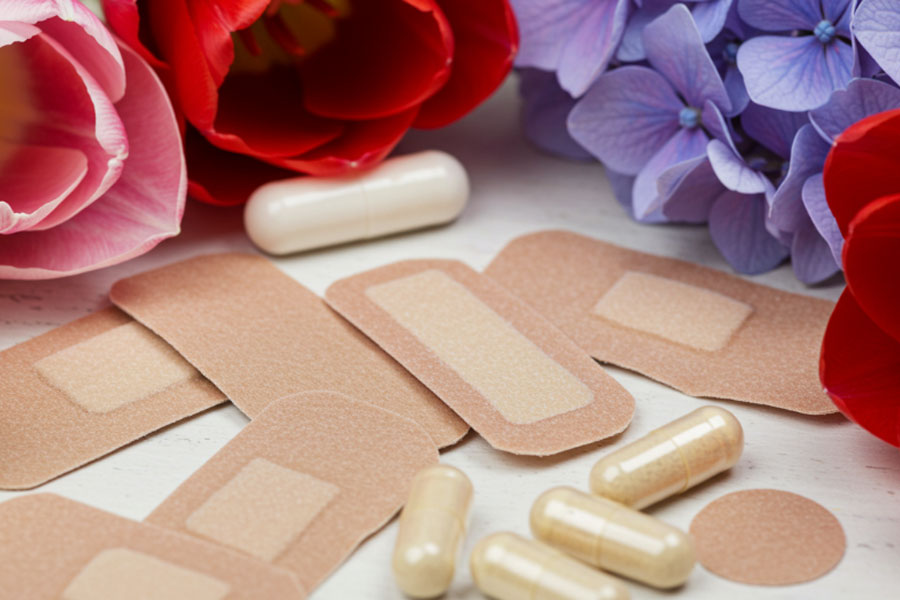Trusted for 25+ Years
Peyronie's Disease: Natural Treatments

Dr. Lisa Lawless, CEO of Holistic Wisdom
Clinical Psychotherapist: Relationship & Sexual Health Expert

What Is It?
Peyronie's disease (penile fibrosis) is a noncancerous condition of the penis where fibrous scar tissue develops and causes it to curve and may cause pain. A curved erection isn't necessarily a cause for concern, but an extreme curve can be problematic and may cause erectile dysfunction (ED).
Signs & Symptoms
- Hardened tissue (plaque) in the penis.
- Pain during an erection.
- Curve in the penis during erection.
- Distortion of the penis (indentation, shortening).

Cases of Peyronie's disease range from mild to severe. Symptoms may develop slowly or appear overnight. In extreme cases, the hardened plaque reduces flexibility, causing pain and forcing the penis to bend or arc during erection. In many cases, the pain decreases over time, but the bend in the penis may remain a problem, making sexual intercourse difficult.
Many researchers believe Peyronie's disease develops following trauma (hitting or bending) that causes localized bleeding inside the penis. If the penis is abnormally bumped or bent, an area where the septum attaches to the elastic fibers may stretch beyond a limit, injuring the lining of the erectile chamber and, for example, rupturing small blood vessels.
Autoimmune Disease
While trauma might explain acute cases of Peyronie's disease, it does not explain why most cases develop slowly and with no apparent traumatic event. It also does not explain why some cases disappear quickly or why similar conditions such as Dupuytren's contracture do not seem to result from severe trauma. Thus, some researchers theorize that Peyronie's disease may be an autoimmune disorder. Learn more about autoimmune disease through our helpful guide: Autoimmune Disease & Sex.
Peyronie's Disease Treatments
Any treatments for Peyronie's disease should always be discussed with your healthcare provider because you do not want to do something that might be detrimental to your health. A urologist may be the best type of physician to see for this condition. Talking to your doctor about your sexuality can feel challenging, so we have put together a helpful guide to help you: How To Talk To Your Doctor About Sex.
Treatment for Peyronie's disease depends on its duration since you began having symptoms. There are two phases that your health care provider will evaluate:
-
Acute Phase
You have pain or changes in the curvature or length of the penis, and this has been going on for two to four weeks or up to a year or longer. During the acute phase, it is recommended to use treatments such as penile traction and medication injections to prevent length loss and minimize the curvature that occurs. It is not recommended to have surgery until the disease has stabilized to avoid needing multiple surgeries.
-
Chronic Phase
You have had no changes in your pain or changes in curvature or length, and this has been going on for about three to twelve months after symptoms begin. Several potential treatments are available for the chronic phase of Peyronie's Disease. These treatments can be done together or alone, including injection, penile traction, and surgery.
May Go Away On Its Own
In roughly 20% of cases, Peyronie's will go away. The damaged area might heal slowly or abnormally after repeated trauma and minimal blood flow in the sheath-like fibers. In cases that heal within about a year, the plaque does not advance beyond an initial inflammatory phase. In cases that persist for years, the plaque undergoes fibrosis, or formation of tough fibrous tissue, and even calcification, or formation of calcium deposits.
Vitamin E
In small-scale studies, some researchers have given Vitamin E orally to men with Peyronie's disease and have reported improvements. Yet, no controlled studies have established the effectiveness of Vitamin E therapy. Similar inconclusive success has been attributed to oral application of para-aminobenzoate, a substance belonging to the family of B-complex molecules.
Medications
Many oral medications have been used to try and treat Peyronie's disease, but most are not effective. Some injected drugs into the penis may reduce the curvature and pain. Typically you will be given a local anesthetic to prevent pain during the injections. They are given in multiple injections over several months and may be used in combination with oral drugs or traction therapy. Collagenase (collagenase clostridium histolyticum or Xiaflex) is the only FDA-approved medication for Peyronie's disease. This drug appears to be most effective when used in conjunction with modeling (traction therapies), which is the forcible bending of the penis in the opposite direction of the curve.
Verapamil, which is usually used to treat high blood pressure, has been found to disrupt the production of collagen, which forms the scar tissue found in Peyronie's disease. The drug may reduce pain and is typically well tolerated. Interferon may also be used as it is a protein that may break down and disrupt the production of fibrous in the penis.
Chemical agents such as verapamil, collagenase, steroids, calcium channel blockers, and interferon alpha-2b directly into the plaques. These interventions are still considered unproven because studies included small numbers of patients and lacked adequate control groups. Steroids, such as cortisone have produced unwanted side effects, such as the atrophy or death of healthy tissues. An anti-inflammatory metalloprotein drug orgotein has had some.
Radiation Therapy
Radiation therapy, in which high-energy rays are aimed at the plaque, has also been used. Like some chemical treatments, radiation appears to reduce pain, but it has no effect on the plaque and can cause unwelcome side effects.
Surgery
Surgery is not typically recommended until you have had Peyronie's disease for at least nine to twelve months and the curvature of your penis stops increasing and stabilizes for at least three to six months.
Peyronie's disease has been treated surgically with some success. The two most common surgical procedures are removal or expansion of the plaque, placement of a patch of skin or artificial material, and removal or pinching of tissue from the side of the penis opposite the plaque, which cancels out the bending effect. The first method can involve partial loss of erectile function, especially rigidity. The second method, known as the Nesbit procedure, causes a shortening of the erect penis.
Some men choose to receive an implanted device that increases the rigidity of the penis. In some cases, an implant alone will straighten the penis adequately. In other cases, implantation is combined with a technique of incisions and grafting or plication (pinching or folding the skin) if the implant alone does not straighten the penis.

Most types of surgery produce positive results. But because complications can occur, and because many of the phenomena associated with Peyronie's disease (for example, shortening of the penis) are not corrected by surgery, most doctors prefer to perform surgery only on the small number of men with curvature so severe that it prevents sexual intercourse.
Traction Therapy (Penis Extenders)
Penile traction therapy is when one uses a penis extender like the one shown and involves stretching the penis to improve penile length and curvature. Depending on the severity, it may need to be worn as little as thirty minutes to eight hours per day.
Penis extenders are also used to assist in making new, healthier, and stronger cells in the penis. They may do this by using stretching motions, increasing blood flow to the penis. As more healthy cells are created, they can support more blood allowing for larger, firmer, longer-lasting erections. For more information about penis extenders, please see our Penis Enhancement Toys Guide.
 Other Treatments
Other Treatments
Shock wave therapy, stem cells, and platelet-rich plasma are also treatments that have been shown to be ineffective in human studies. Some treatments include iontophoresis which uses an electric current to administer a combination of verapamil and steroids through the skin. However, research has shown conflicting results on penile curvature and erectile function.
In Closing
Peyronie's disease is thought to happen in 4 out of 100 men and is typically seen in older men between 40 and 70. In rare cases affects men in their 30s. The number of cases may be higher because many may be embarrassed to seek assistance through their health care provider. However, to determine the severity of Peyronie's disease, you must have a healthcare provider address your concerns. There is no sure way to decide whether or not you have it without a physical examination. You are worth taking care of, and sexual health is simply part of your overall health and is vital for you to nurture to enjoy your life to the fullest.





